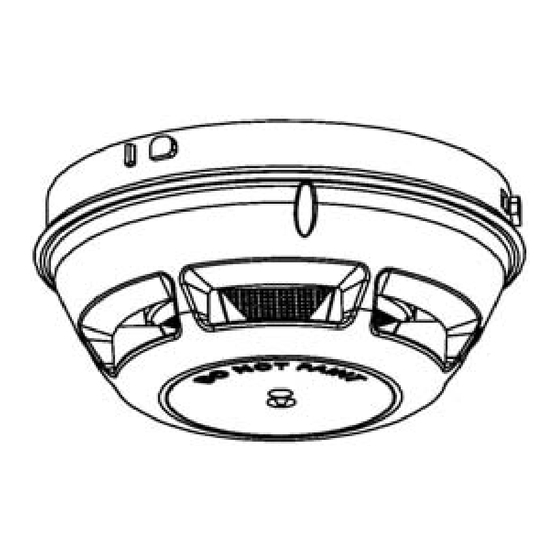Table of Contents
Advertisement
Quick Links
Installation Instructions
Model FDO421
Photoelectric Detector
These instructions are written in accordance with the installation
guidelines of NFPA 72, National Fire Alarm Code, The Installation
of Fire Alarm Systems.
CAUTION
Detection Device Storage
DO NOT install this detection device until all construction
is completed.
DO NOT store this detection device where it can be
contaminated by dirt, dust, or humidity.
DETECTOR PLACEMENT
Although no specific spacings are set for the detectors used for
a clean air application, use 30 foot center spacing (900 sq ft)
from NFPA Standard 72 initiating devices chapter, if practical,
as a guide or starting point for a detector installation layout.
This spacing, however, is based on ideal conditions–smooth
ceiling, no air movement, and no physical obstructions. In some
applications, therefore, considerably less area is protected
adequately by each smoke detector. This is why it is mandatory
to closely follow the installation drawings. In all installations place
the detector on the ceiling, a minimum of 6 inches from a side
wall, or on a wall, 6 inches from the ceiling.
If you have any questions regarding detector placement, follow
the drawings provided or approved by Siemens Industry, Inc.,
or by its authorized distributors. This is extremely important! The
detector placements shown on these drawings were chosen after
a careful evaluation of the area that is protected. Such factors
as air currents, temperature, humidity, pressure, and the nature
of the fire load were carefully considered. Especially noted were
the room or area configuration and the type of ceiling (sloped or
flat, smooth or beamed). Siemens Industry, Inc.'s extensive
experience in the design of the system assures the best detector
placement by following these drawings.
TO AVOID NUISANCE ALARMS
Do not locate the detectors where excessive smoke
concentrations exist under normal conditions, or in areas of
prolonged high relative humidity where condensation occurs.
Do not locate the detectors next to an oil burner, kitchen, or
garage where exhaust fumes can trigger an alarm. Other causes
of false alarms are dust accumulation, heavy concentrations of
steam, heavy pipe or cigar smoke, and certain aerosol sprays.
AIR CURRENTS
Before a detector can sense a fire, the products of combustion
or smoke must travel from the fire to the detector. This travel is
especially influenced by air currents; therefore, consider air
movement when designing the system. While combustion
A6V10323926_a_en_--
Figure 1
FDO421
products tend to rise, drafts from hallways, air diffusers, fans,
etc., may help or hinder the travel of combustion products to the
detector. When positioning a detector at a particular location,
give consideration to windows and doors, both open and closed,
to ventilating systems, both in and out of operation, and to other
factors influencing air movement. Do not install a detector in the
air stream of a room air supply diffuser. It is better to position a
detector closer to an air return.
The distance that products of combustion or smoke travel from
a fire to the detector is not usually the shortest linear route.
Combustion products or smoke usually rise to the ceiling, then
spread out. Average ceiling heights of 8 to 10 feet do not
abnormally affect detector response. High ceilings, located in
churches, warehouses, auditoriums, etc., do affect detector
response and should be considered.
SPECIAL CEILING CONSTRUCTION FACTORS
Ceiling obstructions change the natural movement of air and
combustion products. Depending on the direction of smoke
travel, joists and beams can slow the movement of heated air
and smoke, while pockets between them can contain a reduced
level of smoke. Take obstructions created by girders, joists,
beams, air conditioning ducts, or architectural design into
consideration when determining area protection. Refer to the
Initiating Devices chapter of NFPA Standard 72 for Location and
Spacing requirements for specific types of construction; e.g.
beam, suspended, level, sloped and peaked ceilings. The
detector is also compatible with the following mechanical
protection guard model: STI-9604 (see www.STI-USA.com for
details).
TEMPERATURE – HUMIDITY – PRESSURE – AIR
VELOCITY
The temperature range for the FDO421 detector is 32°F (0°C)
to 120°F (49°C). Use the detector in environments where the
humidity does not exceed 95% (non-condensing). Normal
changes of atmospheric pressure do not affect detector
sensitivity. The air velocity range is 0-4000 ft/min for open areas
applications and direct in air duct applications. Follow detector
spacing and location requirements in NFPA 72 Chapter for High
Air Movement Areas and Control of Smoke Spread.
LED INDICATOR OPERATION
The Model FDO421 contains an LED indicator capable of
flashing either one of three distinct colors: green, yellow, or red.
During each flash interval, the microprocessor-based detector
monitors the following:
•
Smoke in its sensing chamber
•
Smoke sensitivity is within the range indicated on the
nameplate label
•
Internal sensors and electronics
Building Technologies Division
Siemens Industry, Inc.
Advertisement
Table of Contents

Subscribe to Our Youtube Channel
Summary of Contents for Siemens FDO421
- Page 1 VELOCITY the room or area configuration and the type of ceiling (sloped or The temperature range for the FDO421 detector is 32°F (0°C) flat, smooth or beamed). Siemens Industry, Inc.’s extensive to 120°F (49°C). Use the detector in environments where the experience in the design of the system assures the best detector humidity does not exceed 95% (non-condensing).
- Page 2 TO NEXT BASE *The relay contacts are shown after System reset, which represents the non-alarm condition. **FDO421 is a polarity insensitive detector. Line 1 and Line 2 can be either line of the loop. Figure 2 Installation and Wiring Diagram Siemens Industry, Inc.











Need help?
Do you have a question about the FDO421 and is the answer not in the manual?
Questions and answers